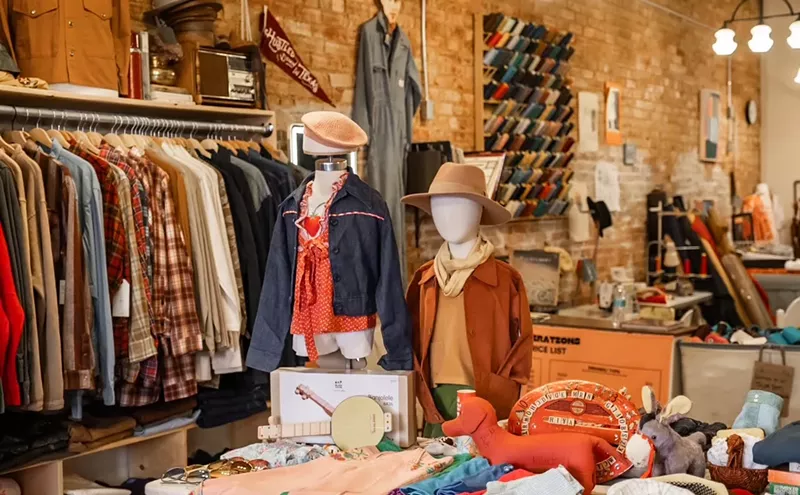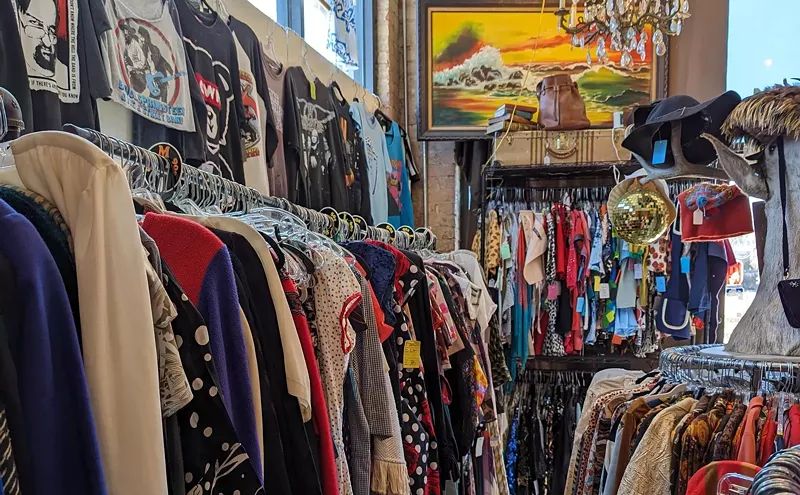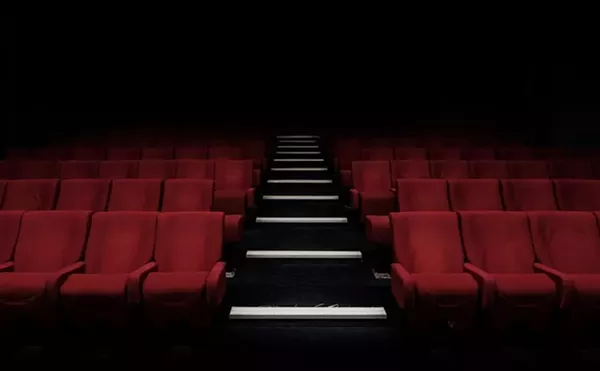There are plenty of reasons to cast a hypercritical eye on the SMU-educated artist, currently the subject of shows at the McKinney Avenue Contemporary and Pillsbury and Peters Fine Art. There's the hometown hype, for starters. It's been a decade since he quit Big D for more hospitable climes, namely the chichi east end of Long Island, and nine long years since Rizzie, now 49, had a solo show in these parts. Yet if Rizzie's gone, he's not forgotten--not by The Dallas Morning News society page, anyway. Of 84 news articles in major papers mentioning Rizzie, more than 50 are DMN items about charity auctions or gossip column sightings, especially plugs in Alan Peppard's column.
In any other case, being party to such silliness would constitute grounds for a good slapping-around in print. But in Rizzie's case, I find myself making excuses. After all, there is the cultural insecurity thing; we Texans never love our homegrown talent until it moves East or West, whereupon we suddenly feel the urge to reclaim long-neglected bragging rights. Absence makes the media and the collectors grow fonder, and sometimes those aren't even two separate categories; both Peppard and the Belo Corp. own Rizzie's work and have loaned examples for the MAC's Rizzie retrospective.
Shameless boosterism aside, there is still good cause to be wary of Rizzie. For those who have forgotten or were too young to know, Dan Rizzie was the local poster boy for the overhyped '80s contemporary art market. Those were simpler, more innocent days, a time before FSLIC and the RTC and recapture were part of the native tongue, a time of $87 million Van Goghs and, more to the point, $300,000 Basquiats. A time when art was an "investment" along with I-30 condos and exotic tax shelters. A time when many otherwise sane people believed in things that were too good to be true, including the kind of art-world promotion that, for a brief time, transformed an immature, unproven painter working in the provinces into a minor celebrity.
Indeed, the ink on Rizzie's MFA was barely dry when he started having museum shows--first the Dallas Museum of Art, eager to promote local artists in Big D, then Fort Worth, then Brooklyn, and New York, and from there the world. He was included in the 1983 Corcoran Biennial. He was feted as part of the Kimbell Museum's "The Artist's Eye" series, and in 1990 had his own show there. He was part of LA County's Third International Art Expo in 1988. Whether through gift or purchase, his work landed in the collections of prestigious museums, including New York's Museum of Modern Art.
There were notes of caution. The critics weren't always wowed by the brightly colored, recycled and simplified cubist collages that were his trademark; a Los Angeles Times reviewer, for example, pronounced Rizzie's work "pleasant but unchallenging."
But the faint praise hardly mattered. Following Warhol's maxim as if it were a playbook, Rizzie parlayed his largely unearned recognition into minor fame. His darkly handsome, macho Marlboro-Man-with-a-brush looks didn't hurt. In 1988, he appeared in full-page ads hawking, of all things, Haggar slacks. In '89 he became a Dewar's Profile, his pretty-boy mug gracing ads and billboards across the land. He did Christmas cards for Neiman Marcus. He painted the columns at the Starck Club, did a mural at 8.0. His fame brought more recognition, which brought collectors, which brought gallery sales. There was a period in the late '80s when any Dallasite with cultural pretensions, from law firms to hoteliers to individual would-be aesthetes, simply had to own a Rizzie.
It didn't just happen, of course. Rizzie's too-much, too-fast career symbolized something else very 1980s: a reputation built the new-fashioned way, on shortcuts. Once upon a time, artists' careers were built slowly, based on reputations laboriously made in a local artists' community and in academe. In bigger art communities, such as New York, small, obscure notices led to bigger, more important notices; experimental venues led to the outer ring of galleries, which led to an inner ring; and from there to museum recognition and a (more or less) sophisticated collecting public. It worked that way here in the sticks, too--the primary difference being that the art press was smaller, the notices more difficult to come by, and the ring of important galleries minuscule.
It all changed in the '80s, when buzz became a sure-fire shortcut to success. And Rizzie, above all his contemporaries, seemed to understand this. He was no monk in the studio, standing by stoically while his dealers doused him in the gasoline of media attention and easy money, then struck a match. He hobnobbed with celebrities, toadied up to tastemakers, actively sought exposure and endorsements. He vacationed in the Hamptons, went to parties, and dated famous women, including former Saturday Night Live cast member Jan Hooks, into whose East Hampton home he moved in the early '90s.
And then came The Crash. And now, perhaps, the Second Act of Dan Rizzie's charmed American life.
But I'm getting ahead of the story.
The First Act is all there, lining the walls of two galleries of the McKinney Avenue Contemporary, in a Rizzie retrospective that runs through October 8.
Like an archaeological refuse pit filled with bones from some ancient bacchanalian feast, the MAC's show is interesting chiefly for its record of that long-gone time. As for the art, well, it's what it always was: great, if derivative, and fun.
Rizzie's territory has always been the border between image and abstraction, and his preferred medium is the painterly collage. He's fascinated with shorthand, with symbols of all sorts, and has spent much of his 20-plus-year career working out a personal iconography. The works on display at the MAC are not necessarily Rizzie's best, but they are well chosen in that they give an inkling of the breadth of his oeuvre, as well as how Rizzie works. In the first gallery in the MAC are small collages, where Rizzie experiments with the motifs and images that appear in his big oils and constructions. And it is in the big oils and constructions that we see him trying on styles, taking what he likes, then trying on another. Thus, we see Rizzie move from Neo-Constructivism ("Two Songs," 1980, and "Untitled," 1981) to Matisse-does-Constructivism ("Two Sisters," 1982), to Matisse-does-cubism ("Rokko Oroshi," 1986), on to Rizzie's pure cubist period ("Heart," 1987).
A hundred years after Cézanne and the cubists, however, this is well-plowed territory. And in the morning-after light of the MAC, Rizzie's central artistic problem jumps out: He doesn't have anything particularly compelling to add. His art is not in any way political. Nor is it particularly regional. Oh, sure, Rizzie sometimes incorporates symbols from his surroundings--"Southern Moon," for example--yet the early work was not concerned with witnessing a people, an area, a local tradition.
Rizzie, in fact, was never really a provincial painter. The son of a career diplomat, Rizzie spent his formative years in exotic locales: Egypt, India, Jordan. Even his family can't quite remember why he selected Dallas for grad school after attending a tiny liberal arts college in Arkansas. And while Rizzie spent 16 years here, it's hard to see exactly how it influenced his painting. Rizzie himself has suggested that the hard, angular forms of this period were somehow associated with Dallas, but it's a mystery why Dallas is to blame. Instead, his sights were set on formal, painterly issues, on manipulating basic shapes and forms, cones and spheres, triangles and rectangles, and clefts, using these simple, universal symbols to publicly express private experiences and emotions. (How much more private can you get than a painting titled "Heart"?)
In this sense, the MAC show reveals him to be a profoundly traditional, conservative artist. It also hints at one of the paradoxes of Rizzie's rise to unwarranted fame: He was feted precisely because he was working in an art-world backwater. Only in a place as rich and unsophisticated as Dallas in the '80s could this work be considered controversial, even cutting-edge. It had a patina of sophistication, a cosmopolitan air. But at the core, it was deeply conventional stuff. It was the perfect art for its place and time. This remains Rizzie's most notable achievement: His late '80s works, big, busy and brightly colored, mock-modern, viewer-friendly, and wildly optimistic, seem the ultimate symbol for late-'80s Dallas.
When Rizzie left Dallas in 1990, it looked like the second shrewdest career move possible. The first, of course, would have been death. Dallas' real estate and banking sectors had begun to melt down, and the gallery system supporting contemporary Texas artists wasn't far behind. Rizzie, perhaps the biggest fish in the Dallas contemporary art pond, made his leap to the big pond of New York, to make his fame and fortune in the greater art world.
And the greater art world yawned.
He decamped for the weekend playground of the art-world elite, where, under the very noses of Manhattan's most powerful dealers, he became invisible.
It should have been no surprise. Manhattan's contemporary art world thrives on exhibitionism and ephemera and The Newest Thing, not Rizzie's recycled modernism. Next to Cindy Sherman, Damien Hirst, and videotape, and rocks piled on the gallery floor, Rizzie's work was decidedly stodgy. To Rizzie's everlasting credit, and despite his penchant for whoring after celebrity, his work has always been about painting, not clever careerism. He's never been relevant or current. He's never been, in short, likely to make a splash in that lake.
Whether it came as a surprise to Rizzie is another matter. It could be that Rizzie thought fickle fame would see him through; it could be that he wanted to drop out. Or it could be that, as Ted Pillsbury puts it, Rizzie "perhaps didn't manage his career as well as some other [local] artists." Whatever the reason, the '90s became a kind of Lost Period for Rizzie. During the first half of the decade, he floated from now-defunct dealer to now-defunct dealer, never finding one with the cash or cachet to catapult him into the big-time. While his promoters say he continued to produce as many major pieces as ever, the work became nearly impossible to find, perhaps because no one cared enough to lock him in the studio and make him produce a show.
Instead, Rizzie seems to have concentrated on graphic work, especially prints and monotypes done at Austin's Flatbed Press. The monotypes, one of which, from 1994, is the only Rizzie work from the period which made it into the MAC's exhibition, show how Rizzie's imagery was changing. Employing directions and images he had abandoned earlier, his symbols became rounder, especially organic: tulips and petunias and the occasional floating teakettle. His focus shifted from creating the illusion of deep space to a preoccupation with surface. He remained an old-fashioned modernist, still exploring paradoxes--old and new, image and abstraction, the personal and the universal. But there was a new emphasis on his surroundings, and a new sensibility.
And slowly, by the end of the '90s, a new career. Rizzie's work doesn't appear to have been exactly flying from the few galleries in which he exhibited; at one point, Rizzie was reduced to hanging pictures in a trendy east-end eatery. But gradually, Rizzie began to put his career on a sounder basis, finding his place among the community of east-end artists--a community that, while not what it once was, still exists. He was invited to participate in local group shows at East Hampton's Guild Hall, as well as at a show in Southampton's tiny Parish Art Museum. He began to get 10-word notices in the Long Island edition of The New York Times. Of course, the few critics who noticed him were still damning Rizzie with faint praise--but at least it was attention, the right kind of attention, and praise.
With the current show of Rizzie's work at Pillsbury & Peters, we get to see what he's been doing.
Anyone eager for the late-'80s Rizzie is going to be disappointed. Gone is the Bud Lite cubist, the bold colorist, the brash young Turk. In his place is a more mature Rizzie, an artist whose work is subtle and simple and balanced, his compositions well-positioned in pictorial space. This time around his primary source material is not high modernism, but English botanical prints. In works like "Tobacco" (2000) and "Onion Flower" (2000), Rizzie is spare, economical, with an emphasis on surface and textures, analogizing antique lace with natural forms, creating a deeply personal imagery of organic shapes and muted colors.
Pillsbury is peddling it as less-is-more. "What I like about his work is that it's gotten simpler," says the 50-something former Kimbell director, now a partner in Gerald Peters' Dallas gallery. The good news is that, in most of the pictures, less is at least not a bore. The most successful pieces, such as "Lily" (2000), are pared down, painterly, ultra-elegant collages that wink at Rizzie's own past and show how far he's come. A less successful group of pictures uses pure abstractions--winding vine-like lines and colored spheres--to represent veins, or the record of Rizzie's wanderings, or even crows in a tree. Interestingly, some of the weakest work in the 31-piece show, which is nearly sold out, evokes the artist's new home. Pieces like "Where I Live" (1994-2000) and "Windmill-Sag Harbor" (2000) seem forced, evidencing no real feel for place and little emotional attachment--even less than some of his '80s work displayed.
Rizzie's new pieces still incorporate the symbols he has used for years: curlicues and colored spheres, shorthand, initials, and abbreviations. The difference is that he's finally forged this shorthand into his own painterly language, a unique style which is contemporary and ancient, vaguely Oriental, and utterly American. The work is still autobiographical, the result of digging deep into Rizzie's own personal history--hence pieces such as "Islamabad" and "Letters from Lucca," a painting in part about Rizzie's travels through Tuscany. Now that the hype is almost gone, for the first time in his career, he's speaking with quiet authority.
There's actually something reassuring about the downward trajectory of Rizzie's career, about the struggle and the now-reasonable prices, about the dignity and maturity of his new work. It's a satisfaction beyond he-flew-too-close-to-the-sun schadenfreude. In fact, it's almost enough to restore one's fragile faith in contemporary art. It will be interesting to see what someone like Ted Pillsbury can do for someone like Dan Rizzie. Maybe there are second acts in American lives.












